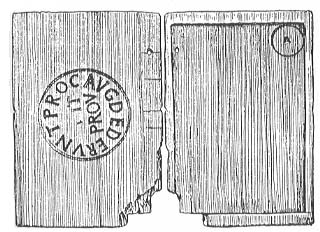
A Corpus of Writing-Tablets from Roman Britain
(A British Academy Research Project)
Project Directors - Dr. A.K. Bowman FBA, Prof. J.M. Brady FRS FEng., Dr. R.S.O. Tomlin FSA, Prof. J.D. Thomas FBA
Research Assistant - Dr J. Pearce

|
A Corpus of Writing-Tablets from Roman Britain(A British Academy Research Project)Project Directors - Dr. A.K. Bowman FBA, Prof. J.M. Brady FRS FEng., Dr. R.S.O. Tomlin FSA, Prof. J.D. Thomas FBA Research Assistant - Dr J. Pearce |
We have received c.200 replies to he letters sent out to museums and archaeological units and other organisations with archaeological holdings . Many of the documents reported from museums and units and noted from references in the archaeological literature were already known. Nevertheless there are significant new discoveries to report, both from museum basements and from recent excavations. Most of these are of individual documents but there are occasional instances of larger numbers, for example of over 60 rolled lead tablets from a rural site near Cirencester.
Documents on lead and wood continue to be found. For example new discoveries are referred to or published in every issue of the journal Britannia (the principal journal for the study of Roman Britain) for the 1990s. As for older excavations, excavations along the Walbrook in London during the 1920s produced several stylus tablets. Several of these were dispersed to museums (including the Royal Ontario Museum in Canada), or entered private collections. One such collection was donated to the Harrogate Museum, from whom we have learnt of the existence of a stylus tablet from the Walbrook, with traces of wax still adhering. In the case of several of these older discoveries the existence of wooden and lead tablets was signalled in excavation reports, but no further work was undertaken and the artefacts have been forgotten or ignored by scholars. Examples of these include a well-preserved stilus tablet from the 1920s excavation of High House milecastle, Cumbria, with some traces of writing, and a wooden tablet from a 1950s excavation of a rural Roman site at Cookham, Berkshire.
The results of the survey, which, it must be stressed, is not yet complete, serve to emphasise the variety of contexts in which writing tablets were used. Lead 'curse' tablets have been documented on thirty-five settlements of all types, at civitas capitals and colonies, smaller towns, villas, rural sites and military sites, even if the largest numbers remain those from temple sites, especially Bath and Uley. Whilst it is possible to identify a cluster of finds in the Westcountry, especially in Somerset, Gloucestershire and Wiltshire, the distribution extends from Eccles in Kent to Ribchester in Lancashire and Malton in North Yorkshire. Wooden writing tablets have also been found in archaeological deposits on twenty settlements, also including civitas capitals and colonies, smaller towns, villas, rural sites and military sites. With the exception of temples, this represents the same range of site types as for lead tablets. Numbers of tablets from Vindolanda and, to a lesser extent, London and Carlisle dwarf those found elsewhere. It is only at Vindolanda and Carlisle that substantial numbers of ink tablets have been reported. Stylus tablets comprise the majority of the finds of individual wooden tablets. Again all regions of Roman Britain are represented, from Somerset and Berkshire in southern England to Newstead in southern Scotland. The occasional discovery of papyrus fragments has been noted. Its susceptibility to decay, even in conditions where other organic materials might be preserved, may mask the extent to which it was used, but given its probable cost and rarity, cheaper alternatives, especially wooden tablets, were probably favoured.
Together even these preliminary results suggest that literacy, or at least the use of documents, was more significant in the lives of a larger proportion of the Romano-British population than has previously been allowed for. Work has already begun on some of the new documents that have been submitted to us. In due course there will be further updates on the progress of the project.
CSAD | Introduction | Letter to museums | Description of curse tablets | Progress report | Images and references